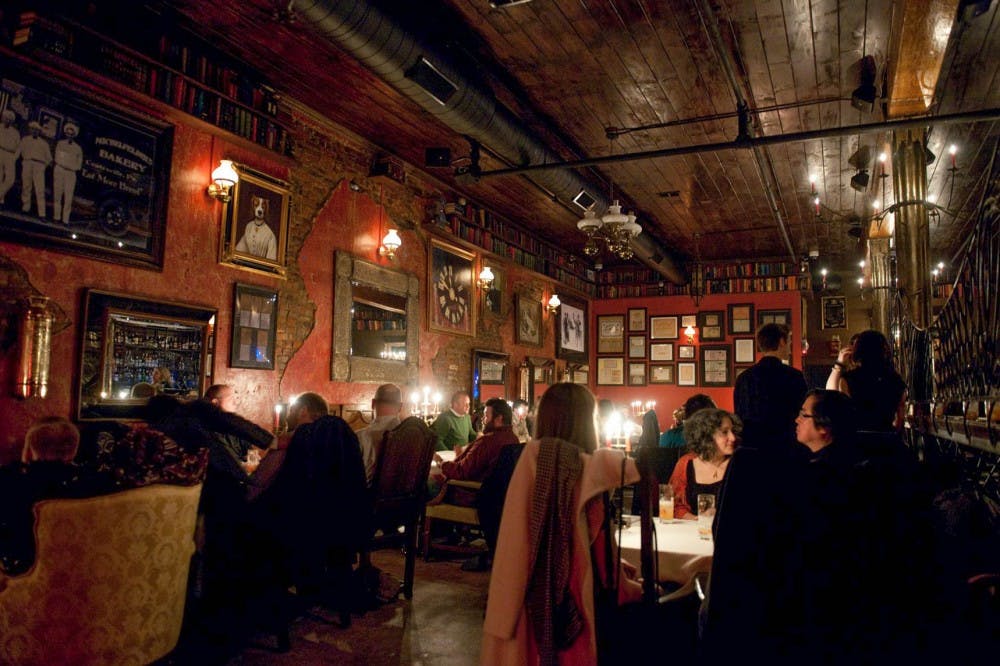Crammed between two nondescript Chinatown buildings, behind an intricately wrought iron gate, through an empty waiting room, there’s a dimly lit room brimming with strong, old–fashioned cocktails. Helmed by an eccentric owner and shrouded in mystery, Hop Sing Laundromat has become something of a Philadelphia lore in the past several years.
Its website is a cryptic single page, quoting David Foster Wallace and explaining how—despite unexpected, pervasive media coverage—their establishment will never live up to your expectations. “After all, this is just a simple bar and not some sort of Prohibition, speakeasy, or retirement resort–themed bar, as we lack the intelligence to execute such a scheme,” the website candidly proclaims. In fact, they “did not even intend to advertise themselves.” Indeed, they have no signage. Despite these concerted efforts, hype prevailed. Condé Nast named it one of the best bars in the world just three years ago, and it’s been on a meteoric rise ever since. And as evidenced by the line up the block many nights, they’re still living with these consequences.

Hop Sing just celebrated its sixth birthday in June, and announced with this momentous occasion that they would be reducing their hours to weekends only. This is not an establishment without public antics, and the local press has covered them with furiosity.
Gaining entrance to Hop Sing has become its own sort of legend, like an easier–to–get–into, buttoned up Berghain. There are rumors of an unofficial dress code: no shorts, no sneakers, no jeans. Upon reaching the front of the line, guests wait until a short, middle–aged man opens an inner door to meet you at the gate across the street from Dim Sum Garden. This is the owner, Lê, a self–described “North Korean ex–pat,” who is the official gatekeeper of the establishment. He’s been the subject of much mystery and speculation in his own right. On his personal Facebook, he posts photos of people who have been banned from the establishment and taunts his patrons, calling them “imperialist Americans.”
In–person, he couldn’t seem any nicer. After a quick scan of our IDs, he led us into a small anteroom where he outlined the rules of the establishment, of which there were two: no talking on the phone, no photos. You can be “texting or Googling,” he clarifies. After the quick crash course, he led us into a dimly lit room with red–painted walls covered in mirrors. Beach Boys plays softly over the surround sound, as waiters in full suits provide full table service to the patrons scattered around the room. The centerpiece of the room is without a doubt the monument wall of liquor bottles, displayed behind a bar top made of coins tiled in clear resin. The interior seems like something of a bar in an Old West railroad town crossed with White Dog, overstuffed yet distressed in all the right places.
Hop Sing exclusively serves cocktails, with a permanent two page drink menu plus an extra sheet of seasonal specials. The choices were paralyzing, and my group opted to try as many as we could. This may have been a mistake, as you can do the trick with about one and a half drinks. For the first round, we opted for three unique cocktails: a Bramble (gin, muddled blackberries, lemon juice, and simple syrup), a Wisconsin iced tea (ginger liqueur, gin, Pimms, falernum, iced oolong, mint, and fresh lemon juice), and a Fuggetaboutit (gin, elderflower liqueur, Campari, falernum, and lime juice). At $16 a piece, the drinks were definitely pricey, but they didn’t skimp on alcohol or flavor. The Wisconsin iced tea and the Bramble did wonders in masking the flavor of the gin, the former being a good mix of disparate flavors and the latter being a little fruitier and lighter. The Fuggetaboutit was a beautiful crimson color, coming garnished with a sculptural orange peel. It had two types of alcohol, and damn could you taste them.
For the second round, we wanted to get a little more experimental. We opted for a Big Spender (gin, yellow chartreuse, falernum, and fresh lemon juice), a Stonewall Riot (vodka, fresh extracted green grape, and orange juice), as well as a Philly Colada (El Dorado rum, Aluna coconut liqueur, fresh pineapple juice, cream, fresh lime, and mint). The Big Spender came in a citrus–y slush, and was small and strong. The Stonewall Riot was the letdown of the night, tasting something like watery celery. But the Philly Colada more than made up for it. It was strong and classic, creamy and foamy in all the right places.
Through all of our liquorous debauchery, we were waited on hand and foot by an attentive waiter, who refilled our water glasses if they ever were less than half full and relit our oil candles no less than five times. We were breathing a little too heavy, which I’ll chalk up to the cocktails doing their job. Stumbling back onto Race Street, we were glad we came. Partly to demystify the place, partly to get our night started out with a bang.
TL;DR: Pricey, stiff cocktails cloaked in a mysterious ambience.
Address: 1029 Race St.
Hours:
Thurs–Fri: 5 p.m.–2 a.m.
Price: ~$15 per cocktail (cash only)







